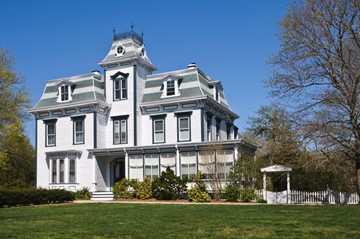October 8, 2021

Every house has a history and a story to tell. Unless your home is brand-new construction, each home carries its unique background and may have some fascinating tales to tell. You might wonder how to trace the history of your home to learn more about it. Each home has a unique set of information attached, from stories of American folklore and people who lived there in decades past to architectural history. Read on to discover how you can find out more about the history of your house, what makes it a historic home, and interesting facts you might uncover along the way.
Why Find Out the History of Your House?
There might be several reasons why you’re interested in learning more about the history of your house, including:
Its architectural history: American homes come in various styles, and they often vary by region. By digging into the history of your house, you’ll learn more about when it was built, how it was built, and its unique architectural style.
Significant features: Every home is unique in different ways, including special features. For example, some historic homes may include a widow’s walk, a dumbwaiter, or an original laundry chute to the house. Learning more about these features and why they were essential to past owners is a great way to uncover the home’s historical significance and what made it special during that time.
Tips for preservation: Once you learn more about the details of your home, you’ll be much better prepared to preserve it. Your local historical society or a local museum may be able to offer you some tips to keep your historic home in excellent condition for future generations.
How to Trace Your Home’s History: Where to Start
To dig deeper into your house history, there are a few places to turn to, so you can research your home history:
Check to see if it’s a historic home: You can look into your home’s history by finding old maps and city records. This information is usually readily available to the public, and it will give you a better idea of when it was built and what the neighborhood looked like during its prime. Look into the city’s history and find out what types of significant events took place. This is another excellent way to gain insight into the significance of your home.
Ask your realtor: A local real estate agent should have more information about the history of your home, or at least of the neighborhood. They may also have contact information and connections to local historians and experts who can give you more details on the background of the property.
Ask the locals: Many older people or those who have lived in the area their entire lives can be an excellent resource. Ask your neighbors and the people in your community if they know more about your street and home. You’d be surprised how many people may have even known the family that once lived there before you.
Visit the local library: If you want to know how to trace your home’s history, the local library is a treasure trove of information. Most libraries maintain records of local properties. You can find everything from detailed maps and possibly photos of the construction of your existing home to books about the area’s history.
Check census records: One way to determine who may have lived in your home prior is through the US Census records. The records won’t tell you the names of the people who lived there, but they should indicate how many people lived there, their ages and genders, and even the approximate cost of the home in years prior.
What Makes a House a Historic Home?
Not all old homes are historic. Here are some key factors that make a house actual, authentic landmark buildings.
It’s connected to significant events: Perhaps your home housed soldiers or people using the Underground Railroad during the Civil War. This would classify the home as being a historic building. Any connection to significant historical events typically ranks a home as a historical one.
Important people lived there: If a famous person or someone well-known once lived in your home, it should be deemed historic.
The home has distinctive characteristics: Look at your home’s architectural history and how it was constructed. For example, a Frank Lloyd Wright home is historical since it was designed and built by a famous architect. In some localities, any homes over 50 years old may be classified as historical and sometimes apply to entire blocks or neighborhoods.
It tells a story: If your home was built using specific construction techniques during one particular period, it could also be considered a historic building. Some houses were built with wooden nails, while others were purchased from the once-famous Sears catalog. These are just two examples of landmark building design that can give certain homes their historical significance.
The Pros and Cons of Living in Historic Homes
Living in a historic home has many benefits, but it can also have a few drawbacks. Here are some of the pros and cons of living in a historic building or home.
Pros
You can help preserve its history: Owning a historic home is exciting, but it also comes with a responsibility to hold it. By owning a house like this, you can help to keep its history alive for future generations to come.
Unique design and beauty: Many historic homes are filled with incredible detail and special features that make them one-of-a-kind. Your home will be unlike many of the newer construction homes we see today, making it more personal and valuable.
Historic districts protect value: If the home is within a historic district, it has a much better chance of maintaining or even increasing its value. These districts have some strict requirements, but they’ve been put in place to protect the homes’ value.
Cons
Limited design options: You might not be able to remodel your kitchen or get the addition you’ve always wanted if your home is historic. Some jurisdictions restrict the homeowner’s ability to change the house, or the home itself could be too fragile or use materials like asbestos that cannot be disturbed.
Higher home insurance: If your home is officially deemed historical, you could face higher homeowner’s insurance premiums. That’s because it would be almost impossible to restore or replace the house to its original glory if it were lost in a flood or fire. Because the home was built using older materials, it’s also considered a high-risk property by many insurance providers.
More costly repairs: A standard home is easier to make repairs on than a historic home. If your home has knob and tube wiring and something goes wrong, you may have to replace the entire home’s electrical system. Homes with a slate roof are also extremely costly to repair. Whether it’s due to the materials used to build the house or systems that are no longer up to code, prepare to pay more if you need certain repairs made to the home.
Structural issues: Older homes will likely face a few structural problems over time. The home’s foundation could be cracked or sinking, or perhaps the attic or floorboards need to be replaced. Keep this in mind when considering buying a historic home.
Other Things You Might Uncover
Aside from the neighborhood and general architectural history, there are some other fascinating things you might learn about your home:
Past residents: With some research, you might learn more about the people who lived in your home. Whether they were a well-known local family or someone famous, it’s a fascinating way to uncover the personal stories of those who once lived there.
Your town’s lore: American lore is filled with fascinating stories, and by learning more about your home, you’ll also learn more about the history and tales of your local community. The Library of Congress is also an excellent resource to help you uncover some stories about your town.
Interesting facts and stories: The more you learn about your home, the more interesting details you can reveal. Even if you don’t live in one of America’s famous houses, you could find out interesting information about the background of who built your home or discover unique stories about the neighborhood as a whole.
You don’t have to live in a Frank Lloyd Wright house or a former US President’s home for your house to be considered historic. Do some research and networking with the locals; you can trace the unique history of your home and learn more about its past. We are all saving these fantastic structures for future generations to learn about and enjoy by preserving historic homes.
Article Provided by:




I like that you said everyone would enjoy living in a historic home because these historic homes are contributing to the preservation of an important part of history.